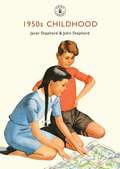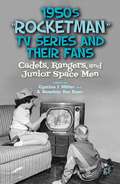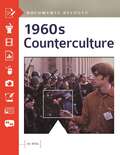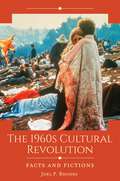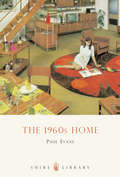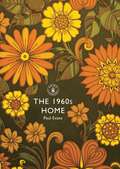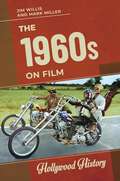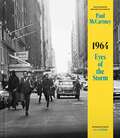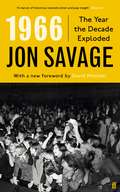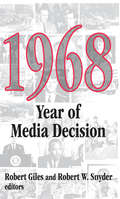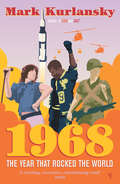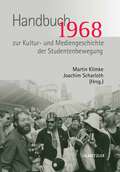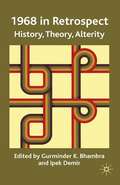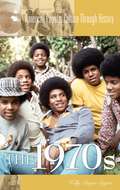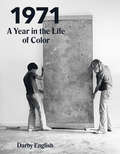- Table View
- List View
1950s Childhood: Growing up in post-war Britain (Shire Library)
by Janet Shepherd John ShepherdChildren of the 1950s have much to look back on with fondness: Muffin the Mule, Andy Pandy, and Dennis the Menace became part of the family for many, while for others the freedom of the riverbank or railway platform was a haven away from the watchful eyes of parents. The postwar welfare state offered free orange juice, milk and healthcare, and there was lots to do, whether football in the street, a double bill at the cinema, a game of Ludo or a spot of roller-skating. But there were also hardships: wartime rationing persisted into the '50s, a trip to the dentist was a painful ordeal, and at school discipline was harsh and the Eleven-Plus exam was a formidable milestone. Janet Shepherd and John Shepherd examine what it was like to grow up part of the Baby Boomer generation, showing what life was like at home and at school and introducing a new phenomenon – the teenager.
1950s “Rocketman” TV Series and Their Fans: Cadets, Rangers, and Junior Space Men
by Cynthia J. MillerThe fourteen essays featured here focus on series such as Space Patrol, Tom Corbett, and Captain Z-Ro, exploring their roles in the day-to-day lives of their fans through topics such as mentoring, promotion of the real-world space program, merchandising, gender issues, and ranger clubs - all the while promoting the fledgling medium of television.
1960s Counterculture: Documents Decoded (Documents Decoded)
by Jim WillisAn era that changed America forever is analyzed through the words of those who led, participated in, and opposed the protest movements that made the 1960s a signature epoch in U.S. culture.There is no better way to understand the 1960s than to read key speeches and texts from the decade, experiencing firsthand writings that capture a signature sense of passion and conviction. That is exactly the approach taken by this book as it analyzes major protest movements of the era, including the Vietnam War protests, the Civil Rights Movement, Women's Lib, the hippie movement, and the nascent GLBQT movement. Organized by movement, the work presents speeches, testimonies, and other important documents side-by-side with accessibly written, expert commentary. The documents and the themes they represent are linked to each other and to events during the decade to put the passionate thinking of the time in context and demonstrate its importance and legacy. By allowing readers to explore the 1960s in this visceral way, the book will provide an engaging learning experience for secondary school and university students, who will also gain helpful insights on how to evaluate historical documents. For the same reason, the volume will be a welcome resource for the general reader interested in understanding—or recalling—why the 1960s produced so many lasting changes in the American psyche.
1960s Counterculture: Documents Decoded (Documents Decoded)
by Jim WillisAn era that changed America forever is analyzed through the words of those who led, participated in, and opposed the protest movements that made the 1960s a signature epoch in U.S. culture.There is no better way to understand the 1960s than to read key speeches and texts from the decade, experiencing firsthand writings that capture a signature sense of passion and conviction. That is exactly the approach taken by this book as it analyzes major protest movements of the era, including the Vietnam War protests, the Civil Rights Movement, Women's Lib, the hippie movement, and the nascent GLBQT movement. Organized by movement, the work presents speeches, testimonies, and other important documents side-by-side with accessibly written, expert commentary. The documents and the themes they represent are linked to each other and to events during the decade to put the passionate thinking of the time in context and demonstrate its importance and legacy. By allowing readers to explore the 1960s in this visceral way, the book will provide an engaging learning experience for secondary school and university students, who will also gain helpful insights on how to evaluate historical documents. For the same reason, the volume will be a welcome resource for the general reader interested in understanding—or recalling—why the 1960s produced so many lasting changes in the American psyche.
The 1960s Cultural Revolution: Facts and Fictions (Historical Facts and Fictions)
by Joel P. RhodesThis book uses evidence-based primary source analysis to provide students with the historical perspective necessary to think critically about the romantic memories, stubborn stereotypes, misperceptions, deliberate falsehoods, distorted myths, and old grudges that distort our popular perceptions of the 1960s.Twenty-first century Americans routinely use the 1960s as a metaphor, a sort of convenient shorthand, for the cultural wars—that continuous clash over differing values, beliefs, attitudes, and lifestyles—still bitterly polarizing the nation. Therefore, understanding the 1960s cultural revolution is critical to understanding ourselves. What this book contributes to that conversation is needed historical perspective with evidence-based primary source analysis.Ten chapters shed light on ordinarily overlooked aspects of the period, challenge stubborn misconceptions, and explore the enduring legacy of the 1960s. Primary source material—both written and visual—is drawn from archival holdings, newspapers, published proceedings, oral histories, and memoirs in order to present a balanced, accessible examination of mistaken beliefs and the historical truths.
The 1960s Home (Shire Library #604)
by Paul EvansThe 1960s witnessed a sustained period of economic growth, consumer spending and stable employment. This hitherto unknown prosperity enabled a market growth in levels of owner occupation and a subsequent boom in the sale of household furnishings and luxury goods. The 1960s Home looks at the styles and fashions in domestic housing and interiors between 1960 and 1970. Although this period has received increasing attention in recent years, much of it has been concentrated on progressive and exclusive design rather than on the furniture and furnishing of the 'average' home.
The 1960s Home (Shire Library #604)
by Paul EvansThe 1960s witnessed a sustained period of economic growth, consumer spending and stable employment. This hitherto unknown prosperity enabled a market growth in levels of owner occupation and a subsequent boom in the sale of household furnishings and luxury goods. The 1960s Home looks at the styles and fashions in domestic housing and interiors between 1960 and 1970. Although this period has received increasing attention in recent years, much of it has been concentrated on progressive and exclusive design rather than on the furniture and furnishing of the 'average' home.
The 1960s on Film (Hollywood History)
by Jim Willis Mark MillerThe 1960s on Film tells the narrative of the 1960s through the lens of the movie camera, analyzing 10 films that focus on the people, events, and issues of the decade.Films create both an impression of and — at times for younger audiences — a primary definition of events, people, and issues of an era. The 1960s on Film examines the 1960s as the decade was presented in ten films that focused on that decade. Discussion will focus on both what the films have to say about the era and how close they come to accurately depicting it.For example, films such as Mississippi Burning and Selma tell the story of racial conflict and hope for reconciliation in the 1960s. Other films such as The Right Stuff and Hidden Figures show the deep fascination America had at that time with the burgeoning space program and NASA, while Easy Rider analyzes the role of rock music and drugs among young people of the decade. The Deer Hunter studies the controversies surrounding the war in Vietnam. The Graduate, Mad Men, JFK, and Thirteen Days also receive significant treatment in this exciting volume.
The 1960s on Film (Hollywood History)
by Jim Willis Mark MillerThe 1960s on Film tells the narrative of the 1960s through the lens of the movie camera, analyzing 10 films that focus on the people, events, and issues of the decade.Films create both an impression of and — at times for younger audiences — a primary definition of events, people, and issues of an era. The 1960s on Film examines the 1960s as the decade was presented in ten films that focused on that decade. Discussion will focus on both what the films have to say about the era and how close they come to accurately depicting it.For example, films such as Mississippi Burning and Selma tell the story of racial conflict and hope for reconciliation in the 1960s. Other films such as The Right Stuff and Hidden Figures show the deep fascination America had at that time with the burgeoning space program and NASA, while Easy Rider analyzes the role of rock music and drugs among young people of the decade. The Deer Hunter studies the controversies surrounding the war in Vietnam. The Graduate, Mad Men, JFK, and Thirteen Days also receive significant treatment in this exciting volume.
1964: Eyes Of The Storm
by Paul McCartneyPhotographs and Reflections by Paul McCartney'Millions of eyes were suddenly upon us, creating a picture I will never forget for the rest of my life.'In 2020, an extraordinary trove of nearly a thousand photographs taken by Paul McCartney on a 35mm camera was re-discovered in his archive. They intimately record the months towards the end of 1963 and beginning of 1964 when Beatlemania erupted in the UK and, after the band's first visit to the USA, they became the most famous people on the planet. The photographs are McCartney's personal record of this explosive time, when he was, as he puts it, in the 'Eyes of the Storm'.1964: Eyes of the Storm presents 275 of McCartney's photographs from the six cities of these intense, legendary months - Liverpool, London, Paris, New York, Washington, D.C. and Miami - and many never-before-seen portraits of John, George and Ringo. In his Foreword and Introductions to these city portfolios, McCartney remembers 'what else can you call it - pandemonium' and conveys his impressions of Britain and America in 1964 - the moment when the culture changed and the Sixties really began.1964: Eyes of the Storm includes:- Six city portfolios - Liverpool, London, Paris, New York, Washington, D.C. and Miami - and a Coda on the later months of 1964 - featuring 275 of Paul McCartney's photographs and his candid reflections on them- A Foreword by Paul McCartney- Beatleland, an Introduction by Harvard historian and New Yorker essayist Jill Lepore- A Preface by Nicholas Cullinan, Director of the National Portrait Gallery, London, and Another Lens, an essay by Senior Curator Rosie Broadley
1964 - 2004: Aufbruch, Aufstieg und neue Ungewissheit
by Werner LindnerVierzig Jahre nach dem programmatischen Sammelwerk "Was ist Jugendarbeit?" treffen damalige Initiatoren der Kinder- und Jugendarbeit auf jene, die sich gegenwärtig um neue Konzepte des sich verändernden Handlungsfelds bemühen. Vor dem Hintergrund der Theorieansätze von 1964 wird erneut untersucht, welche Orientierungen für professionelle, theoretische und gesellschaftspolitische Verortung der Kinder- und Jugendarbeit künftig bestehen.
1966: The Year the Decade Exploded
by Jon SavageThe pop world accelerated and broke through the sound barrier in 1966. In America, in London, in Amsterdam, in Paris, revolutionary ideas slow-cooking since the late '50s reached boiling point. In the worlds of pop, pop art, fashion and radical politics -- often fueled by perception-enhancing substances and literature -- the 'Sixties', as we have come to know them, hit their Modernist peak. A unique chemistry of ideas, substances, freedom of expression and dialogue across pop cultural continents created a landscape of immense and eventually shattering creativity. After 1966 nothing in the pop world would ever be the same. The 7 inch single outsold the long-player for the final time. It was the year in which the ever lasting and transient pop moment would burst forth in its most articulate, instinctive and radical way. Jon Savage's 1966 is a monument to the year that shaped the pop future of the balance of the century. Exploring canonical artists like The Beatles, The Byrds, Velvet Underground, The Who and The Kinks, 1966 also goes much deeper into the social and cultural heart of the decade through unique archival primary sources.
1968: Year of Media Decision
by Robert Giles Robert W. SnyderThirty years ago American political life was all relentless, painful, and confounding: the Tet Offensive brought new intensity to the Vietnam War; President Lyndon Johnson would not seek re-election; Martin Luther King, Jr. and Robert Kennedy were assassinated; student protests rocked France; a Soviet invasion ended "socialism with a human face" in Czechoslovakia; the Mexican government massacred scores of peaceful demonstrators; and Richard M. Nixon was elected president. Any one of the events of 1968 bears claim to historical significance. Together they set off shock waves that divided Americans into new and contending categories: hawks and doves, old and young, feminists and chauvinists, straights and hippies, blacks and whites, militants and moderates. As citizens alive to their own time and as reporters responsible for making sense of it, journalists did not stand aside from the conflicts of 1968. In their lives and in their work, they grappled with momentous issues--war, politics, race, and protest.
1968: The Year that Rocked the World
by Mark KurlanskyIt was the year of sex and drugs and rock and roll; it was also the year of the Martin Luther King and Bobby Kennedy assassinations, the Prague Spring, the Chicago convention, the Tet offensive in Vietnam and the anti-war movement, the student rebellion that paralysed France, civil rights, the beginning of the end for the Soviet Union, and the birth of the women's movement. With 1968: The Year that Rocked the World, award-winning journalist Mark Kurlansky has written his Magnum opus - a cultural and political history of that world-changing year of social upheaval, when television's impact on global events first became apparent, and when simultaneously - in Paris, Prague, London, Berkeley, and all over the globe - uprisings spontaneously occurred. 1968 encompasses the worlds of youth and music, politics, war, economics, assassinations, riots, demonstrations and the media, and shows us how we got to where we are today.
1968: Year of Media Decision
by Robert SnyderThirty years ago American political life was all relentless, painful, and confounding: the Tet Offensive brought new intensity to the Vietnam War; President Lyndon Johnson would not seek re-election; Martin Luther King, Jr. and Robert Kennedy were assassinated; student protests rocked France; a Soviet invasion ended "socialism with a human face" in Czechoslovakia; the Mexican government massacred scores of peaceful demonstrators; and Richard M. Nixon was elected president. Any one of the events of 1968 bears claim to historical significance. Together they set off shock waves that divided Americans into new and contending categories: hawks and doves, old and young, feminists and chauvinists, straights and hippies, blacks and whites, militants and moderates. As citizens alive to their own time and as reporters responsible for making sense of it, journalists did not stand aside from the conflicts of 1968. In their lives and in their work, they grappled with momentous issues--war, politics, race, and protest.
1968. Handbuch zur Kultur- und Mediengeschichte der Studentenbewegung
Die 68er polarisieren noch heute: Politisch gescheitert, erfolgreich in der Entwicklung neuer Lebensstile? Dabei gingen Kulturrevolution und Medienevolution Hand in Hand. Presse, Rundfunk und Fernsehen stilisierten Rudi Dutschke, die Kommune I, Che Guevara oder Mao neben den Rolling Stones oder Jimi Hendrix zu Ikonen einer jugendlichen Protestkultur. War die 68-Bewegung mehr als die Inszenierung von Ereignissen im Medienformat? Entlang der Stichworte Happening, Sit-in, Diskussionsfieber, Protestinszenierung u. a. vermittelt das Handbuch einen neuen Blick auf eine politische Strömung, die die Jahrzehnte danach entscheidend verändert und geprägt hat.
1968 in Europe: A History of Protest and Activism, 1956–1977 (Palgrave Macmillan Transnational History Series)
by M. Klimke J. ScharlothA concise reference for researchers on the protest movements of the 1960s and 1970s, this book covers the history of the various national protest movements, the transnational aspects of these movements, and the common narratives and cultures of memory surrounding them.
1968 In Retrospect: History, Theory, Alterity
by Gurminder K. Bhambra Ipek DemirThis volume examines the protest movements of 1968 from innovative perspectives. With contributions from leading social theorists the book reflects on the untold narratives of race, gender and sexuality and critically addresses the standard theoretical assumptions of 1968 to discuss overlooked perspectives.
1968 In Retrospect: History, Theory, Alterity (PDF)
by Gurminder K. Bhambra Ipek DemirThis volume examines the protest movements of 1968 from innovative perspectives. With contributions from leading social theorists the book reflects on the untold narratives of race, gender and sexuality and critically addresses the standard theoretical assumptions of 1968 to discuss overlooked perspectives.
The 1970s (American Popular Culture Through History)
by Kelly Boyer SagertFew conventions were left unchallenged in the 1970s as Americans witnessed a decade of sweeping social, cultural, economic, and political upheavals. The fresh anguish of the Vietnam War, the disillusionment of Watergate, the recession, and the oil embargo all contributed to an era of social movements, political mistrust, and not surprisingly, rich cultural diversity. It was the Me Decade, a reaction against 60s radicalism reflected in fashion, film, the arts, and music. Songs of the Ramones, the Sex Pistols, and Patti Smith brought the aggressive punk-rock music into the mainstream, introducing teenagers to rebellious punk fashions. It was also the decade of disco: Who can forget the image of John Travolta as Tony Manero in Saturday Night Fever decked out in a three-piece white leisure suit with his shirt collar open, his hand points towards the heavens as the lighted disco floor glares defiantly below him? While the turbulent decade ushered in Ms. magazine, Mood rings, Studio 54, Stephen King horror novels, and granola, it was also the decade in which over 25 million video game systems made their way into our homes, allowing Asteroids and Pac-Man games to be played out on televisions in living rooms throughout the country. Whether it was the boom of environmentalism or the bust of the Nixon administration and public life as we knew it, the era represented a profound shift in American society and culture.
1970s Childhood (Shire Library)
by Liza HollinghurstA 1970s childhood was, for many, a life of happy-go-lucky freedom set against a soundtrack of pop music played on a transistor radio dangling from the handlebars of a Raleigh Chopper. It was a playground battlefield of Sindy versus Action Man or a dexterous display of how to handle Clackers without painfully rapping them across the knuckles. After-school television meant a choice of 'Blue Peter' or 'Magpie', while chewing on an Aztec chocolate bar and flicking through Shoot or Jackie magazine. Yet it was also a decade of strikes, the three-day week and the Winter of Discontent which passed most children by unless a power cut meant no television. This fully illustrated book is a celebration of that childhood, its highs, lows and scraped knees, that will readily bring back the forgotten memories of a generation that grew up without mobile phones, the internet and 24-hour shopping.
1970s Childhood (Shire Library #859)
by Liza HollinghurstA 1970s childhood was, for many, a life of happy-go-lucky freedom set against a soundtrack of pop music played on a transistor radio dangling from the handlebars of a Raleigh Chopper. It was a playground battlefield of Sindy versus Action Man or a dexterous display of how to handle Clackers without painfully rapping them across the knuckles. After-school television meant a choice of 'Blue Peter' or 'Magpie', while chewing on an Aztec chocolate bar and flicking through Shoot or Jackie magazine. Yet it was also a decade of strikes, the three-day week and the Winter of Discontent which passed most children by unless a power cut meant no television. This fully illustrated book is a celebration of that childhood, its highs, lows and scraped knees, that will readily bring back the forgotten memories of a generation that grew up without mobile phones, the internet and 24-hour shopping.
1971: A Year in the Life of Color
by Darby EnglishIn this book, art historian Darby English explores the year 1971, when two exhibitions opened that brought modernist painting and sculpture into the burning heart of United States cultural politics: Contemporary Black Artists in America, at the Whitney Museum of American Art, and The DeLuxe Show, a racially integrated abstract art exhibition presented in a renovated movie theater in a Houston ghetto. 1971: A Year in the Life of Color looks at many black artists’ desire to gain freedom from overt racial representation, as well as their efforts—and those of their advocates—to further that aim through public exhibition. Amid calls to define a “black aesthetic,” these experiments with modernist art prioritized cultural interaction and instability. Contemporary Black Artists in America highlighted abstraction as a stance against normative approaches, while The DeLuxe Show positioned abstraction in a center of urban blight. The importance of these experiments, English argues, came partly from color’s special status as a cultural symbol and partly from investigations of color already under way in late modern art and criticism. With their supporters, black modernists—among them Peter Bradley, Frederick Eversley, Alvin Loving, Raymond Saunders, and Alma Thomas—rose above the demand to represent or be represented, compromising nothing in their appeals for interracial collaboration and, above all, responding with optimism rather than cynicism to the surrounding culture’s preoccupation with color.
1971: A Year in the Life of Color
by Darby EnglishIn this book, art historian Darby English explores the year 1971, when two exhibitions opened that brought modernist painting and sculpture into the burning heart of United States cultural politics: Contemporary Black Artists in America, at the Whitney Museum of American Art, and The DeLuxe Show, a racially integrated abstract art exhibition presented in a renovated movie theater in a Houston ghetto. 1971: A Year in the Life of Color looks at many black artists’ desire to gain freedom from overt racial representation, as well as their efforts—and those of their advocates—to further that aim through public exhibition. Amid calls to define a “black aesthetic,” these experiments with modernist art prioritized cultural interaction and instability. Contemporary Black Artists in America highlighted abstraction as a stance against normative approaches, while The DeLuxe Show positioned abstraction in a center of urban blight. The importance of these experiments, English argues, came partly from color’s special status as a cultural symbol and partly from investigations of color already under way in late modern art and criticism. With their supporters, black modernists—among them Peter Bradley, Frederick Eversley, Alvin Loving, Raymond Saunders, and Alma Thomas—rose above the demand to represent or be represented, compromising nothing in their appeals for interracial collaboration and, above all, responding with optimism rather than cynicism to the surrounding culture’s preoccupation with color.
1971: A Year in the Life of Color
by Darby EnglishIn this book, art historian Darby English explores the year 1971, when two exhibitions opened that brought modernist painting and sculpture into the burning heart of United States cultural politics: Contemporary Black Artists in America, at the Whitney Museum of American Art, and The DeLuxe Show, a racially integrated abstract art exhibition presented in a renovated movie theater in a Houston ghetto. 1971: A Year in the Life of Color looks at many black artists’ desire to gain freedom from overt racial representation, as well as their efforts—and those of their advocates—to further that aim through public exhibition. Amid calls to define a “black aesthetic,” these experiments with modernist art prioritized cultural interaction and instability. Contemporary Black Artists in America highlighted abstraction as a stance against normative approaches, while The DeLuxe Show positioned abstraction in a center of urban blight. The importance of these experiments, English argues, came partly from color’s special status as a cultural symbol and partly from investigations of color already under way in late modern art and criticism. With their supporters, black modernists—among them Peter Bradley, Frederick Eversley, Alvin Loving, Raymond Saunders, and Alma Thomas—rose above the demand to represent or be represented, compromising nothing in their appeals for interracial collaboration and, above all, responding with optimism rather than cynicism to the surrounding culture’s preoccupation with color.
